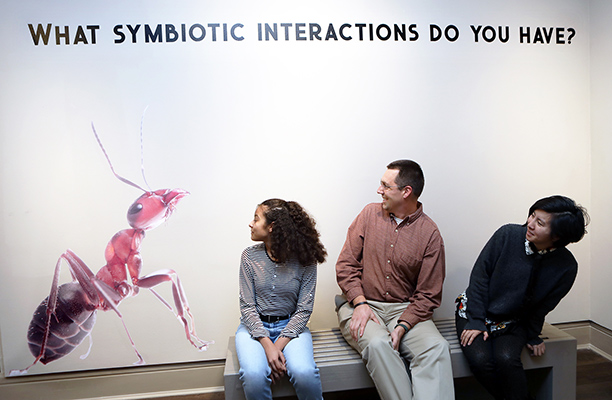New UTEP Exhibit Shows How Ants Contribute to World Ecosystems
Last Updated on February 12, 2020 at 12:00 AM
Originally published February 12, 2020
By UC Staff
UTEP Communications
Unbelievably, fewer than 1% of ants are pests. The rest are valuable members of the Earth’s environment. Those 99 percenters are the basis of “Tiny Tunnels, Big Connections: Ant Relationships Shape the World,” that opens Thursday, Feb. 13, 2020, in The University of Texas at El Paso’s Centennial Museum and Chihuahuan Desert Gardens.

One of the exhibit’s goals is to raise awareness of the wide variety of ant species and the role they play in the circle of life, said Vicky Zhuang, Ph.D., exhibit curator and collections manager at UTEP’s Biodiversity Collections. Ants aerate soil and distribute plant seeds. They also are a food source for birds, lizards and even humans. For example, honey pot ants, known for their consumption of nectar, are sweet delicacies in Mexico.
“Ants do a lot of the heavy lifting for the ecosystem,” Zhuang said. “It’s very impressive.”
While there are an estimated 22,000 species of ants in the world, the exhibition includes about 100 species that thrive throughout the Paso del Norte region as well as Central and South American countries. Visitors will see ants as food, farmers, combatants and relationship experts. The display includes numerous photos, about 150 ant specimens along with enlarged 3D versions of some ant species, and a clever augmented reality “tree.” Visitors who scan the tree with their smartphones or other hand-held electronic devices will see an animated ant’s journey along with text about an ant’s life. There also are various family-friendly items geared toward children.
Many pieces of the exhibit and part of its inspiration comes from William Mackay, Ph.D., professor emeritus of biological sciences and curator of the Biodiversity Collections’ insect specimens. Although officially retired from UTEP, Mackay continues to work on his 50-plus years of ant research that has taken him around the world.
As he spoke about ants, his voice quickened and his face became more expressive. He rattled off species names and their peculiarities, such as which type lived in which trees or bushes and how they live symbiotically with other species. He estimated that he has 500,000 ant specimens that represent 2,500 species in his collection to include 145 species that he discovered. He shared information at a rate similar to a swarm of ants on a food source.
“People don’t realize how interesting they are,” said Mackay, who encouraged the public to visit the exhibit. “They may not be spectacular, but if you stop and watch them, they’re fascinating.”
Claudia Ley, the museum’s education curator, said she expects the exhibit to attract many school visitors and families throughout the summer months. The exhibit is set to close Aug. 8, 2020.
“We believe younger children will enjoy our interactive components,” Ley said.
Daniel Carey-Whalen, director of the Centennial Museum and Chihuahuan Desert Gardens, said that part of the museum’s mission is to share the research of UTEP professors.
“We are grateful to be able to present a small portion of Dr. Mackay’s ant collection, and are pleased that he served as a consultant,” Carey-Whalen said.
One of Mackay’s former students, Shawn Dash, Ph.D., assistant professor of biological sciences at Hampton University in Hampton, Virginia, was the exhibit’s main consultant and fact checker. Dash earned his doctorate in ecology and evolutionary biology at UTEP in 2011. He initiated the main concept and some of the display ideas about the interactions.
Several UTEP undergraduates who worked with Zhuang to process the Mackay ant collection also helped to write labels, pick specimens and install displays for the exhibit.
“I’ve never thought about ants before this project and I think I’ve now processed over 20,000 ants,” said Muriel Norman, a senior biological science major and a curatorial assistant. “It’s amazing to think how unique some of these ant species are.”
Funds for this exhibit come from a grant that the National Science Foundation (NSF) awarded in 2017 to Eli Greenbaum, Ph.D., associate professor of biological sciences and director of the Biodiversity Collections. The NSF’s Division of Biological Infrastructure presented Greenbaum, the project’s principal investigator, with a $166,000 Advancing Digitization of Biodiversity Collections grant. The project reserved some of the funds for a public museum exhibit.
“The ability to share this information in a public way allows (our faculty members’) research to have broader impact,” Carey-Whalen said.